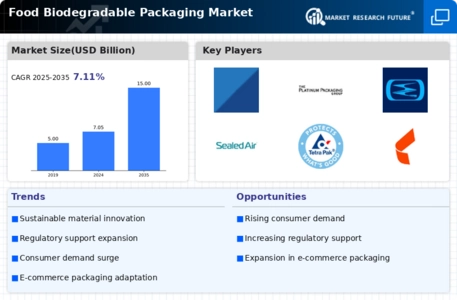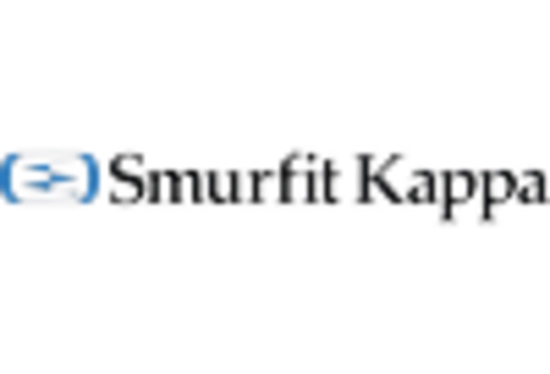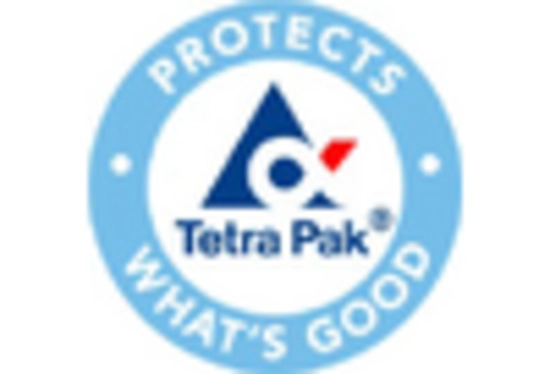Market Trends
Introduction
As we enter 2024, the biodegradable food packaging market is going through a period of transformation, driven by a combination of macroeconomic factors. Advances in material science are making it possible to develop new biodegradable products that meet both performance and sustainability criteria. At the same time, regulatory pressures are growing, with governments introducing more stringent regulations to reduce the use of plastics and promote more eco-friendly alternatives. Lastly, a growing number of consumers are choosing to buy products in packaging that is more sustainable, as consumers become more demanding and expect companies to deliver on their ethical commitments. These trends are strategically important for industry players, influencing not only product development and positioning, but also the competitive landscape of an industry on the cusp of major change.
Top Trends
-
Increased Regulatory Support
It is true that in recent years, governments have been placing more and more restrictions on the use of disposable plastics and have been promoting the use of biodegradable alternatives. For example, the European Union’s single-use plastics directive aims to reduce the amount of plastic waste by a large margin. These regulations have been a great incentive to companies to develop biodegradable packaging. To comply with these regulations, businesses have had to adapt their operations, which in turn has improved their sustainable credentials. It may be that in the future, we will see more comprehensive regulations on biodegradable materials. -
Consumer Demand for Sustainability
A growing number of consumers are demanding sustainable packaging. According to Mintel, 72% of consumers are prepared to pay more for eco-friendly options. Tetra Pak is responding by developing packages that are fully re-usable and biodegradable. Brands are rethinking their packaging strategies and investing more in sustainable materials. This trend is expected to continue as consumers continue to prioritise sustainability in their purchasing decisions. This may result in a market shift towards more biodegradable products across different industries. -
Technological Advancements in Materials
But the most important development is the introduction of new materials, such as starch-based polymers and polylactic acid (PLA), which are degradable. Using them for the manufacture of biodegradable products is a new field of activity for companies such as BASF, which is developing new formulations to improve their degradability and functionality. These developments are making it possible to meet both the demands of the environment and the performance requirements for packaging. With the technology developing further, the improved properties of the materials and the improved performance of the production processes are expected to continue. These advances could lead to an increased use of biodegradable packaging in many different industries. -
Collaboration Across the Supply Chain
In order to find a way out of this dilemma, it is essential that manufacturers, suppliers, and retailers work together. The Biodegradable Packaging Alliance is a good example of a group of companies that have come together to share their knowledge and resources. This is making the development process more efficient and reducing the cost of innovation. If more players get involved, the biodegradable technology could develop more rapidly. This could change the dynamic of the supply chain in the packaging industry. -
Rise of Compostable Packaging Solutions
BioBag International is the leader in this field. This is because research has shown that compostable materials break down better in industrial composting plants, and this makes them more attractive to consumers who are concerned about the environment. This is why companies are looking for alternatives to improve their green credentials. A further development could be a better composting system to support this growing market. This could have a major effect on the food industry and its waste disposal practices. -
Focus on Lifecycle Assessment
The life cycle assessment (LCA) is becoming an increasingly important tool for evaluating the impact of packaging materials on the environment. LCAs are increasingly used to guide the choices of companies. LCAs ensure that biodegradable solutions are truly sustainable. Smurfit Kappa, for example, has incorporated LCAs into its product development process. This focus on LCAs is changing consumer perceptions and their buying behaviour. As LCAs become more standardised, they may lead to greater transparency in the packaging industry. This may also result in further innovations in the field of biodegradable materials. -
Investment in Biodegradable Startups
Biodegradable packaging companies are attracting more and more venture capital, which reflects the growing interest in sustainable solutions. Several companies are now developing new biodegradable materials and processes. The venture capital is helping the start-ups to expand and develop new products. If this trend continues, we will see a growing number of biodegradable solutions to meet the different needs of consumers. This could give rise to a more competitive market for packaging. -
Integration of Smart Packaging Technologies
The development of smart packaging, which makes it possible to combine the functions of biodegradable materials with the engagement of consumers, is an example of this. Sealed Air is experimenting with smart features that provide real-time information on the freshness of the product. It is this combination that is proving attractive to consumers who are concerned about both sustainability and convenience. As smart packaging develops further, we can expect to see more and more applications of this type in the field of biodegradable formats. This trend will change the way consumers interact with packaging and may even influence their buying decisions. -
Global Expansion of Biodegradable Options
Despite the fact that the demand for biodegradable packaging is growing worldwide, there is a lack of production capacity. In Asia-Pacific, the market is growing strongly and companies are responding to local needs. For example, Platinum is developing its range of biodegradable products to meet different preferences. This global growth is forcing companies to adopt local production and distribution strategies. And this is where the future lies: tailor-made biodegradable solutions that meet the local regulatory requirements and the expectations of consumers. -
Enhanced Consumer Education and Awareness
Brands are beginning to focus on educating consumers about the benefits of biodegradable packaging. They are investing in advertising campaigns that inform consumers about the advantages of these materials from an environmental perspective. These campaigns are proving to be effective. According to research, consumers who are better informed are more likely to choose sustainable products, which in turn influences the market. Brands may therefore have to adjust their communication and their product range to meet the new needs. This could ultimately result in an increase in demand for biodegradable packaging solutions.
Conclusion: Navigating the Food Biodegradable Packaging Landscape
The biodegradable food packaging market is characterized by high competition and significant fragmentation. Among the main players, the leading players and the newcomers are struggling for market share. The geographical trends show a strong trend towards sustainable solutions, especially in North America and Europe, where regulations and the desire for eco-friendly products are driving innovation. Strategically, suppliers are relying on artificial intelligence, automation and flexibility to increase the efficiency of production and meet the diverse needs of consumers. The companies that are the most sustainable will be the leaders of the future. The decision-makers should focus on these trends in order to take advantage of the opportunities in this dynamic market.

















Leave a Comment